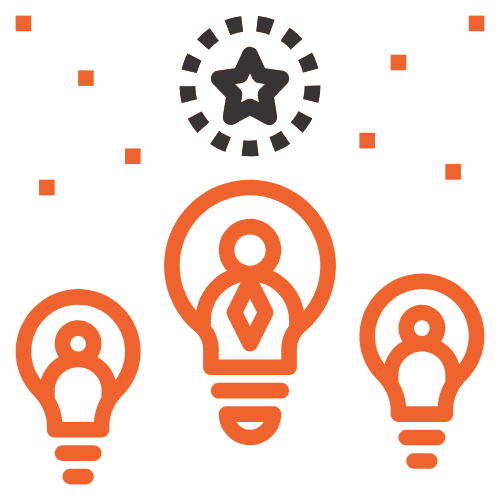
If you’ve ever followed up on a Facebook friend suggestion, checked your smartphone weather app before you went to the zoo, or checked into a flight from your computer, then you already know a little bit about how big data for a competitive edge works.
Little kernels of wisdom that you manage every day from your computer or mobile device are kernels called data for a competitive edge
When Netflix has you scanning for their other recommendation after your This Is Us binge, they are preventing you from hitting up Amazon or Spotify. In other big businesses, one oil company alone that used big data for a competitive edge cut their operating costs by up to 25 percent and increased production by 5 percent.
In the last year alone, the use of big data by big companies has grown from 40 to 60 percent. That means that if you aren’t using big data to add value to your organization, you are losing money by the minute.
Bookmark this guide to utilizing data for a competitive edge moving forward.

Why Use Data for a Competitive Edge?
The number one reason that any business does anything is to make money. That is the single most important reason to use data for ensuring you maintain a competitive edge in your market.
Consumers today give data through devices in what seems like every time they move or even breathe. How hot is it outside? How cool was it inside?
Can data from outside be used to make a decision from indoors on what we will wear outside today? Yes. Believe it or not, this same way of thinking can be utilized almost just as simply with the data you already have on your business. Every decision can be broken down to a monetary value that can be used to make a company more money, better company processes, help companies stay on top of their competition and so much more.
We look at how other businesses in many different industries perform when using big data, to determine its effectiveness in the competitive arena. The numbers don’t lie.
If you aren’t using data for a competitive edge, your organization is losing money.
How many times have you purchased a recommended product on Amazon or eBay? You were able to do so because of big data.
If you are a Capital One customer or Netflix user, then you know bad things happen when data mistakes are made.
Many consumer polls show that consumers today have come to depend on companies using big data, with 72 percent of consumers saying they expect big companies to know what they need.
From health care to commercial airlines, using big data works.

Big Data in Health Care Example
A study on United States health care revealed that members of the health care system that used big data for a competitive edge would add more value to their business.
This ultimately saves American taxpayers as much as 8 percent on their annual health care costs and also keeps more money in the business of the everyday health care office or clinic all across the nation.
Health care businesses alone stand to increase in value by $300 billion annually when they use big data for a competitive edge.

Big Data Goes to the Zoo
Before you make the decision to take the family out for the day, you look up some information to do so in the twenty-first century. Point Defiance Zoo in Washington State knows this and uses that data to make decisions.
As a result of that, they were able to stop siphoning human resource costs down the drain. They knew through big data that a sunny day at the zoo would bring in about 6,000 visitors while a cloudy day would only bring in about 1,000 visitors.
With that information, they were able to schedule staff accordingly and accurately and save on costs.
Big data could save your business thousands of dollars a year, if not millions.

How Are You Using Your Data?
We may be preaching to the choir when it comes to the need to use big data in your business. But all of the numbers in the world won’t help you use data for a competitive edge if you aren’t using the information properly.
To put money back into your business, you need to learn how to use the big data that you find. It’s the difference between knowing when to schedule staff or not schedule staff on a cloudy zoo day.
These are called judgment calls that every project manager and human resources departments struggle with every day. You still need to make judgment calls when you are using big data to be competitive.
But your judgment calls will be more informed, and this empowers you, and your business, to keep making informed decisions with big data.
You can save thousands. For your business, checking the weather forecast may not be enough to help you to save or make money using data.
Most businesses that are going to the next level know they need to use data but aren’t sure how to do it in a winning way. This is one of those situations where spending money in the short-term to make money in the long-term works.
If you are already putting money into using data for a competitive edge, but aren’t seeing the return yet, it’s possible you are using it wrong. Don’t beat yourself up over it.
That self-awareness is half the battle to winning big using big data.
You may just need to organize your resources a little more productively or learn how to use data in a successful way.

1. Organize Your Big Data Resources
One very common mistake that many companies are making is that they are not using their data resources efficiently. For some companies that is because they are inundated with information daily, and just don’t have the resources to manage that effectively.
Imagine an airline for example, that could obtain hundreds of pieces of data about one traveler alone on any given day. All of that data can be used to increase the airline’s bottom line.
That traveler will then expect that airline to intuitively understand them better the next time.
But today’s businesses often get overwhelmed by data analysis. One study showed that 25 percent of time could be saved when some workgroups organized data by transferring it from one location to the next.
It’s the equivalent of the productivity level of a factory worker that keeps moving the same knob back and forth and back and forth over and over again all day. Is that employee being productive?
Is your big data human resource being used efficiently? Businesses waste time on internal data inefficiency.
Is yours?

2. Learn About Your Customer
The more data you have about the people giving your business revenue, the more likely you are to make money from them again. Experts attending a Delivering Alpha conference noted that something as simple as adding the rewards program to Starbucks changed their business model completely.
Your business needs a system in order to get to know your customers better. You may need to hire younger talent to help you do this.
Many graduates today are learning at business school how to incorporate big data for a competitive edge. It’s known as developing the “hybrid employees” of the world.
They help you learn about your customers using cutting-edge analytics.
Using big data for a competitive edge adds value to your business in a number of ways. It’s your own form of market research, without spending budget lines on market research.
It’s your own form of market research, without spending budget lines on market research
The more you know your customers, the more you will give them what they need. When you give them what they need, they come back for more.

3. Do Not Set-It and Forget-It
A common mistake that businesses make when it comes to using data for a competitive edge is that they use it as a set-it and forget-it function.
In big data use, you need to go a little deeper into your data collection and analysis than that.
Do not set it and forget it. See it, and do it.
To accomplish that you need a goal, a plan, and a strategy to execute the plan.
In business, this is called end-to-end implementation. You can not expect extreme results in your plan overnight.
You also can’t expect perfect results the first time. You need to keep testing your data to see what it yields.

4. Big Data is Real-Time Data
Many companies find success with big data because they know how to use it in real-time. Let’s go back to the airline example for a minute.
It’s very useful to know on average how many pieces of checked luggage your customers are willing to spend extra on. And if you can have that answer for every day of business for the last 7 days, you can see real trends emerge.
It’s not enough anymore for businesses to just know that they need to use data for a competitive edge. You need to know how to use it in real-time.
That is because if you are the owner of the aforementioned airline, and aren’t using that data, the airline at the kiosk next to you is. And they are getting your traveler’s data next time, or even this time.
Real-time data targeting keeps you competitive because then you can immediately upsell to your clients or customers while they are giving you data. Amazon, Netflix, eBay, and every retail outlet online, has used this model.
That’s why you wind up spending more when you are shopping online. You go to Wal-Mart to buy socks and wind up with $400 worth of men’s clothing and a new TV.
You could be upselling to your pre-existing customers right now while you read this if your business understands how to use big data as a real-time money maker for you.

5. Big Data Assists in Monitoring Employee Productivity
A key resource in your organization is your human resources. You want to make money on the floor of your business through your buyers or customers, but you also want to save money in daily operations.
Big data helps you to do this. And this isn’t about spying on your employees, any more than it is spying on your customers.
If you know what makes your employees work more efficiently and productively, you help yourself to succeed. And you keep your human resources around a little bit longer!
Numerous studies have shown that happy employees stick around with you and help you to make more money. When you use big data to learn more about your employees, you use it to help make their lives better.
When your employee knows that they are winning on the job, they become healthier and more productive human beings. That means less sick days for you to cover, and even fewer mental health days or personal time taken.
From the machines that your employees use to their movements throughout the day, you can have access to big data on your employees that can help you to streamline their days.
It is just one more way that big data is bringing more value to everyday businesses.

Begin Using Data Today
As the technological revolution continues, today’s big businesses must start using data for a competitive edge. Even if you aren’t a big business, but want to be, data is going to be your leading tool to begin putting money back into your organization’s bottom-line.
One example illustrating this is the smartphone with GPS capability, which is expected to reach 70 percent of the market by 2020. That factor alone has the potential to stimulate over $500 billion into the economy beyond 2020.
How this occurs is by saving the everyday driver a lot of money and time. By having a GPS on your smartphone, you save approximately 10 to 15 hours on the road every year.
This saves America as a whole over $150 billion on fuel consumption alone. That is because drivers use their own data to make decisions.
Take that to the business world and you are looking at a very big piece of the pie for your company. Some analysts even say that using data for a competitive edge has only reached about 10 percent of the maturity of its life cycle.
Don’t try and make this pie all by yourself the first time. That’s our job.
Contact the experts that monetize data for Fortune 5000 companies today.
Give us a call at (301) 560-7901, shoot us an e-mail at info@boostlabs.com, or Contact us today to learn more and let’s take this exciting next step together.
